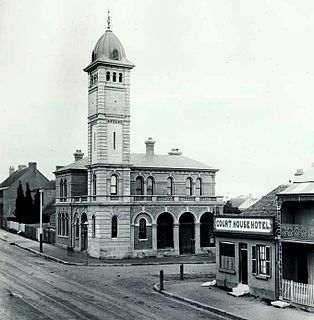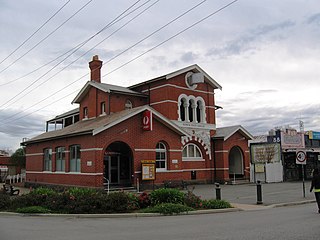
Rockhampton Post Office is a heritage-listed former post office at 80 East Street, Rockhampton, Rockhampton Region, Queensland, Australia. It was designed by George St Paul Connolly and built from 1892 to 1896 by Dennis Kelleher. It is also known as Rockhampton Post and Telegraph Offices. It was added to the Queensland Heritage Register on 24 January 2003.

The Port Pirie Post Office is a heritage-listed post office at 79-83 Ellen Street, Port Pirie, South Australia. It was designed by Edward Woods and built in 1880, with extensions designed by Charles Owen-Smyth built in 1905-1907. It was added to the South Australian Heritage Register on 12 October 1995 and added to the Commonwealth Heritage List on 8 November 2011.

The Paddington Post Office is a heritage-listed post office located at 246 Oxford Street in Paddington, a suburb of Sydney, New South Wales, Australia. The post office is owned and operated by Australia Post, an agency of the Australian Government. The building was also a former telephone exchange. It was designed by the New South Wales Colonial Architect’s Office under James Barnet and later Walter Liberty Vernon, and was built by William Farley. The building was added to the Commonwealth Heritage List, the New South Wales State Heritage Register on 22 December 2000, and the Register of the National Estate.

Forbes Post Office is a heritage-listed post office at 118 Lachlan Street, Forbes, Forbes Shire, New South Wales, Australia. It was designed by the New South Wales Colonial Architect's Office under James Barnet and built from 1879 to 1881 by P. M. Vaughan. The property is owned by Australia Post. It was added to the New South Wales State Heritage Register on 22 December 2000. It was added to the Australian Commonwealth Heritage List on 22 June 2004.

The Tamworth Post Office is a heritage-listed post office located at Fitzroy Street, Tamworth in the Tamworth Regional Council local government area of New South Wales, Australia. It was designed by the Colonial Architect's Office under James Barnet and built by W. C. Cains. The property is owned by Australia Post and was added to the New South Wales State Heritage Register on 22 December 2000.

Kempsey Post Office is a heritage-listed post office at Belgrave Street, Kempsey, Kempsey Shire, New South Wales, Australia. It was designed by the Colonial Architect's Office under James Barnet, and was built by Gabriel and McMorrine, with additions in 1903-04 built by Hocking Brothers. The property is owned by Australia Post. It was added to the New South Wales State Heritage Register on 22 December 2000.

Narrabri Post Office is a heritage-listed post office at 138-140 Maitland Street, Narrabri, New South Wales, Australia. It is also known as Narrabri Post Office and former Telegraph Office. It was designed by the NSW Colonial Architect's Office under James Barnet and built by FA King in 1888. It was added to the Australian Commonwealth Heritage List on 08 November 2011.

Temora Post Office is a heritage-listed post office at 173 Hoskins Street, Temora, New South Wales, Australia. It was added to the Australian Commonwealth Heritage List on 8 November 2011.

Bundaberg Post Office is a heritage-listed post office at 155a Bourbong Street, Bundaberg Central, Bundaberg, Bundaberg Region, Queensland, Australia. It was added to the Australian Commonwealth Heritage List on 8 November 2011.

Charters Towers Post Office is a heritage-listed post office at 17 Gill Street, Charters Towers City, Charters Towers, Charters Towers Region, Queensland, Australia. It was added to the Australian Commonwealth Heritage List on 8 November 2011.

Stanthorpe Post Office is a heritage-listed post office at 14 Maryland Street, Stanthorpe, Southern Downs Region, Queensland, Australia. It was designed by John Smith Murdoch of the Queensland Government Architect's office and was built by D. Stewart and Co in 1901. It was added to the Australian Commonwealth Heritage List on 22 June 2004.

Maryborough Post Office is a heritage-listed post office at 227 Bazaar Street, Maryborough, Fraser Coast Region, Queensland, Australia. It was designed by Charles Tiffin and built in 1865-1866. It was added to the Australian Commonwealth Heritage List on 8 November 2011.

Redfern Post Office is a heritage-listed former residence and now post office located at 113 Redfern Street in the inner western Sydney suburb of Redfern in the City of Sydney local government area of New South Wales, Australia. It was designed by the Colonial Architect’s Office under James Barnet and built by Goddard and Pittman. The property is owned by Australia Post, an agency of the Australian Government. It was added to the New South Wales State Heritage Register on 22 December 2000.

Euroa Post Office is a heritage-listed post office at 90 Binney Street, Euroa, Victoria, Australia. It was designed by John Thomas Kelleher of the state Public Works Department, possibly with the assistance of A. J. McDonald, and built in 1890 by George Diggle. It was added to the Australian Commonwealth Heritage List on 22 August 2012.

Traralgon Post Office and Court House is a heritage-listed post office and former court house complex at 161-169 Franklin Street, Traralgon, Victoria, Australia. It was designed by John Thomas Kelleher and J. R. Brown of the colonial Department of Public Works and built in 1886. The entire building was added to the Victorian Heritage Register on 20 August 1982, with the federally-owned post office wing also being listed on the Australian Commonwealth Heritage List on 8 November 2011.

Hamilton Post Office is a heritage-listed post office at 57 Gray Street, Hamilton, Victoria, Australia. It was designed by C. H. E. Blackman of the colonial Public Works Department under the aegis of William Wardell, built in 1876, and occupied in 1878. It was added to the Australian Commonwealth Heritage List on 8 November 2011.

Kyneton Post Office is a heritage-listed post office at 113 Mollison Street, Kyneton, Victoria, Australia. It was designed by Peter Kerr of the colonial Public Works Department and built in 1870-71. It was added to the Australian Commonwealth Heritage List on 8 November 2011.

Castlemaine Post Office is a heritage-listed post office at 202 Barker Street, Castlemaine, Victoria, Australia. It was added to the Australian Commonwealth Heritage List on 8 November 2011.

Stawell Post Office is a heritage-listed post office at 87-89 Gold Reef Mall, Stawell, Victoria, Australia. It was designed by Alfred T. Snow of the colonial Department of Public Works and built by Thomas Walker in 1874-75. It was added to the Australian Commonwealth Heritage List on 22 June 2004.

Launceston Post Office is a heritage-listed post office at 68-72 Cameron Street, Launceston, Tasmania, Australia. It was designed by William Waters Eldridge, with alterations prior to opening designed by Corrie and North. It opened in 1891, while the clock tower was completed in 1903 and altered in 1910. It was added to the Australian Commonwealth Heritage List on 22 June 2004.





















